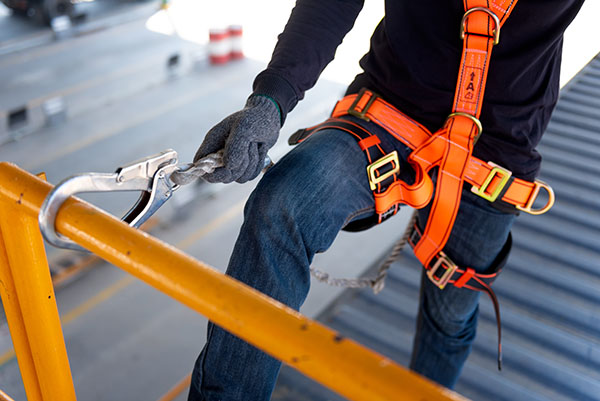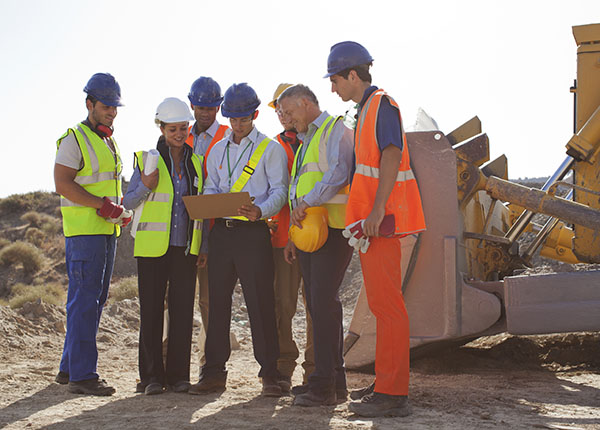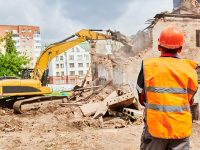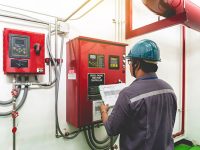Hazards and Safety in Construction
Construction sites are busy places. Many contractors work side-by-side and heavy vehicles come and go.
In this environment consultation, cooperation and coordination are essential to ensure the health and safety of everyone on site.
They are also a requirement for businesses under the WHS Act.
Construction work: Definition
Construction work includes any work involving:
- construction
- renovation, refurbishment, alteration, conversion
- fit out
- commissioning / decommissioning a building or structure
- maintenance and repair
- demolition / dismantling.
Apart from involving buildings, roads and other major structures, construction work also includes:
- any installation or testing carried out in connection with construction work
- the removal from the workplace of any product or waste resulting from demolition
- prefabrication or testing of elements, at a place specifically established for the construction work, for use in construction work
- the assembly of prefabricated elements to form a structure, or the disassembly of prefabricated elements forming part of a structure
- any installation, testing or maintenance of an essential service in relation to a structure
- any work connected with an excavation
- any work connected with any preparatory work or site preparation (including landscaping as part of site preparation) carried out in connection with an activity referred to as construction work
- carried out on, under or near water, including work on buoys and obstructions to navigation.
Work health and safety duties
At each step of the process in construction work, PCBUs are subject to certain general and specific duties under the WHS laws. For example:
- The WHS Regulations require the person that commissions construction work to consult with the designer of a structure about safety matters and to give the designer and the principal contractor for the project information about safety matters.
- A PCBU that carries out construction work must manage and control WHS risks associated with that work. It must also ensure that a construction site is secured from unauthorised access.
- The principal contractor for a construction project is also a PCBU and must be aware of the WHS duties that apply to all PCBUs that carry out construction work, as well as the specific duties that are imposed on principal contractors in that industry.
- Specific duties that apply to principal contractors include, but are not limited to, the duty to be clearly identified by signage posted at the construction site, the duty to prepare, review, keep and inform others about the WHS management plan for the construction project.
- Under the WHS Act, the person with management or control of a workplace must ensure, so far as is reasonably practicable, that the workplace, the means of entering and exiting the workplace and anything arising from the workplace are without risk to the health and safety of any person.
-
The model ‘Code of Practice for Construction Work’ should be read in conjunction with other codes on specific hazards and control measures relevant to the construction industry including:
- Demolition Work
- Excavation Work
- Safe Design of Structures
- Managing the Risk of Falls at Workplaces
- Preventing Falls in Housing Construction
- Managing Electrical Risks at the Workplace
- Managing Noise and Preventing Hearing Loss at Work
- Confined Spaces
- Hazardous Manual Tasks
- How to Manage and Control Asbestos in the Workplace
- How to Safely Remove Asbestos
High risk construction work
In the construction industry, a PCBU that carries out high risk construction has additional WHS duties. These include requirements to prepare, keep, comply with and review a ‘Safe work method statement’ for the work and provide the safe work method statement to the principal contractor.
High risk construction work:
- involves a risk of a person falling more than 3 m (S.A.)
 is carried out on a telecommunication tower
is carried out on a telecommunication tower- involves demolition of an element of a structure that is load-bearing
- involves demolition of an element of a structure that is related to the physical integrity of the structure
- involves, or is likely to involve, disturbing asbestos
- involves structural alteration or repair that requires temporary support to prevent collapse
- is carried out in or near a confined space
- is carried out in or near a shaft or trench deeper than 1.5 m or a tunnel
- involves the use of explosives
- is carried out on or near pressurised gas mains or piping
- is carried out on or near chemical, fuel or refrigerant lines
- is carried out on or near energised electrical installations or services
- is carried out in an area that may have a contaminated or flammable atmosphere
- involves tilt-up or precast concrete
- is carried out on, in or adjacent to a road, railway, shipping lane or other traffic corridor in use by traffic other than pedestrians
- is carried out in an area of a workplace where there is any movement of powered mobile plant
- is carried out in areas with artificial extremes of temperature
- is carried out in or near water or other liquid that involves a risk of drowning
- involves diving work.
Requirements for carrying out construction work
To be able to carry out construction work, a person must complete an introductory safety training course called ‘general construction induction training’. This is also commonly known as ‘white card’ training.
Some types of construction work require a high-risk work licence such as:
- Scaffolding work
- Dogging and rigging work
- Crane and hoist operation
- Reach stackers
- Forklift operation
- Pressure equipment operation
Risk management
You need to know what work activities may pose a risk in your workplace and do whatever you can to eliminate or minimise those risks. This is called the risk management process and involves four steps:
- Identify hazards – find out what could cause harm.
- Assess risks, if necessary – understand the nature of the harm that could be caused by the hazard, how serious it could be and the likelihood of it happening.
- Control risks – implement the most effective and reasonably practicable control measures.
- Review control measures – ensure they are working as planned.
Hierarchy of risk control
The ways of controlling risks are ranked from the highest level of protection and reliability to the lowest. This is known as the hierarchy of risk control.
Where possible, implement the highest order risk controls.
Level 1
- Eliminate: Remove the hazard completely from the workplace, such as removing trip hazards or disposing of unwanted chemicals. This is the most effective control measure a
- nd must always be considered before anything else.
Level 2
- Substitute: Substitute or replace the hazard with a less hazardous work practice, such as replacing solvent-based paints with water-based paints.
- Isolate: As much as possible, separate the hazard or hazardous work practice from people by distance or using barriers.
- Engineering controls: These are physical control measures, such as using a trolley to lift heavy loads.
Level 3
- Administrative controls: These should only be considered when other higher order control measures are not practicable. These are work methods or procedures that are designed to minimise the exposure to a hazard, such as developing a procedure or using signs to warn people of a hazard.
- Personal protective equipment (PPE): Ear muffs, hard hats, masks, gloves, protective eyewear and other forms of PPE should be a last option as they do nothing to change the hazard itself. Effectiveness also relies on the proper fit, use and maintenance of the equipment.
In some cases, you may need to implement a combination of control measures to provide the highest level of protection that is reasonably practicable.
When selecting and implementing a combination of control measures it’s important that you consider whether any new risks might be introduced as a result
Keeping records
Keeping records of your risk management process can assist in demonstrating potential compliance with work health and safety legislation. It can also help you to monitor the health and safety performance of your business.
There are some specific record-keeping requirements in the WHS Regulations for some hazards, such as hazardous chemicals and asbestos. If such hazards are identified at your workplace, you must keep the relevant records for the time specified.
The detail and extent of recording will depend on the size of your workplace and the potential for major work health and safety issues.
Activities with other duty holders
There are often situations where more than one business or undertaking operates at a workplace and where people share WHS responsibility to varying degrees, such as construction projects.
Where more than one person has a duty for the same WHS matter, each person retains responsibility for their duty in relation to the matter and must discharge the duty to the extent to which the person can influence and control the matter.
Each person must also consult, co-operate and co-ordinate activities with all other persons who have a WHS duty in relation to the same matter, so far as is reasonably practicable
Work-related fatalities and injuries statistics in construction – Source from Safe Work Australia
Fatalities – When it comes to work-related fatalities, the most recent statistics from the Construction Industry Profile show that between 2003–13, 401 workers died on construction sites in Australia. The majority of those (28% or 112 workers) involved falls from a height:
- 40 involved ladders, mobile ramps, stairways and scaffolding
- 32 involved a fall from a roof
- 17 involved buildings under construction or demolition.
Other fatalities during this period were made up of:
- vehicle collisions 16% (65)
- electrocution 15% (61)
- being hit by a moving object 12% (48)
- being hit by a falling object 11% (46)
- being trapped between or in equipment 8% (31)
- other causes 9% (38).
- cuts and open wounds (31%)
- sprains and strains (21%)
- chronic joint or muscle conditions (16%).
These injuries were mainly due to:
- hitting or being hit by an object (31%)
- lifting, pushing or pulling objects (30%)
- falls from a height (15%).





